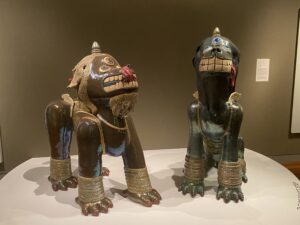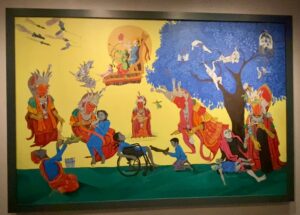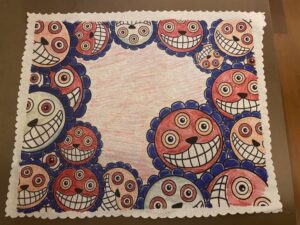My trip to the Rubin Museum of Art was overall very peaceful and unique. I have never been to a museum unveiling the diversity of Asian art, and I enjoyed the atmosphere and unifying displays centered around this theme. As for my personal connection with the art, initially, and with full honesty, a lot of the art did not necessarily speak to me and I struggled to find direct “communication”. Each piece felt more like a history lesson as opposed to communicating a deeper meaning. Maybe this was because of the repetitive nature of the pieces, or because of my preexisting bias of NYC art museums. However, as I gave the museum a chance, some pieces did insight thought and particularly grasped my attention. Through trial and error with different artwork, I was reminded how eye opening it is to feel a connection to cultures outside of your own. Below I have listed a few works held in the museum most memorable to my experience!
1) LUKHANG TEMPLE MURALS
By far, my favorite piece from the Rubin trip were the Lukhang Temple Murals. From a distance, especially if you have bad vision like me, it seemed like there was a lot going on the canvas, a scattered array of people and objects. However, as you got closer, the detail put into these works could really be appreciated. For example, my favorite snippet of the vast figures was of the cycle of life, displaying the inevitable experience of birth and death. What I enjoyed most about this was that it was evident that the artist was trying to convey the cycle of life, despite using a random assortment of symbols. I did not have to stand anxiously pondering about the meaning, and it was rather clear and easy to appreciate. More specifically, the lovers in bed represent the conception of life, the organs being the development of a fetus, and the children being the end result. Additionally, overarching these images, is a rather gory cluster of detached body parts, most likely portraying death. Thus, this whole section particularly spoke to me, as I love seeing how the simple theme of life is perceived and expressed by artists in endless ways.


2) MALE GUARDIAN DOG and FEMALE GUARDIAN DOG by SHUSHANK SHRESTHA
This display is by far the best representation of a “history lesson” I took part in during my visit. Upon initial glance at these statues, I remember finding them to be silly-looking and I got a good chuckle from their exotic body structure. After reading the description, it turns out that these dogs are a small part of Nepal’s culture which I was, evidently, rather unaccustomed to. The dogs are actually replicas of lions, which are deemed to represent protection and power. The artist combined this symbol from Kathmandu, his homeland, and used his own two pet dogs as the foundation of the sculpture to embody this time enduring symbol. I am still left a little confused, though, how such a meaningful, powerful entity was created into such an unserious cartoon dog. As for the art style, despite being made only last year, it was consistent with the South Asian art style and culture depicted across the museum.


3) COMPASSION by JASMINE RAJBHANDARI
Finally, for the last painting of the few that have resonated with me most of my visit, is the work titled Compassion, which my feelings upon it adapted as I took in the entirety of the piece. At first glance, it was uneasy to look at, at least in my opinion, due to the dominant use of primary colors and the alignment of 2D shapes on a flat, bright yellow background. But contrastingly, staring through this discomfort, the painting was quite alluring in the aspect that it shows the themes of health and healing, something I am interested in. Also, even though I do not necessarily relate to the religious intentions of the painting (the Buddhist gods shown), I was still able to admire its connections to human tragedies in war. The philosophy of how humans are entirely capable of both destruction and mending has always been a fascination of mine.

Nonetheless, my visit to the Rubin was a fun trip and it introduced me to a new culture of art. Through experimentation with the many art pieces that were displayed, I was able to learn more about myself and the way I individually decipher what makes something art. I also enjoyed the hands-on interactivity in the museum. My favorite of the few experiences was when I was offered to color a tapestry to be hung outside the museum for its closure next month. I guess now I can forever brag that my art (whether or not it being art can maybe be debated in class) was (sort of) hung up at a museum!



